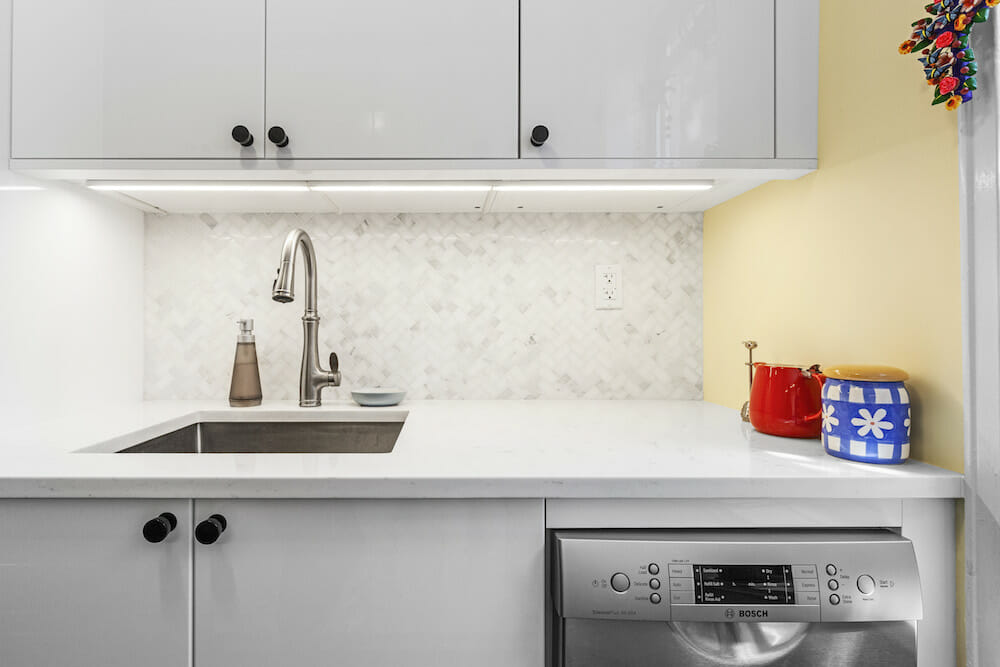Shaker-Style Cabinets: Origins & Styling Tips
See how Shaker-style cabinets complement many home styles—from farmhouse and industrial, to beach-y and classic

(Above) Renovation with Shaker cabinets by Sweeten homeowners Amy + Kevin
Shaker-style cabinets have been a steadfast and dominating kitchen trend. Popularized by the all-white kitchen farmhouse look, painted Shaker cabinets in colors like blue, green, and gray are now commanding attention in kitchen remodels. But, the original Shaker cabinet was natural wood. Sweeten finds out why they’re a perennial favorite.
Sweeten matches home renovation projects with vetted general contractors, offering advice, support, and secure payments—for free.
The origin of Shaker-style cabinets
Speaking of the original Shaker cabinet, where did this design come from? And why, are they so popular?
Shaker cabinets were developed by the Shakers, a group derived from the English Quakers and Methodists. They emigrated to New York state from England in 1774. Their communities grew throughout New England and westward in Kentucky, Ohio, and Indiana.
Part of their beliefs included simplicity and order. Working with their hands led them to become entrepreneurs and craftspeople. They earned a reputation for high-quality furniture building, among other skills. From this, the Shaker-style cabinet was born.
Renovate to live, Sweeten to thrive!
Sweeten brings homeowners an exceptional renovation experience by personally matching trusted general contractors to your project, while offering expert guidance and support—at no cost to you.
(Above) Renovation with mint Shaker-style cabinets by Sweeten homeowners Laura + Tim
What are Shaker-style cabinets?
A Shaker-style cabinet door is a simple, five-panel door. It is made of a flat frame with squared edges using cope-and-stick, or stile-and-rail, construction. It has a flat, non-ornate, recessed inner panel.
The design of Shaker cabinets is reflective of their makers. Quality craftsmanship followed Shaker’s beliefs in simplicity and order, and so did the design of the cabinet door itself. Form followed function since the utility was important. As such, Shaker-style furniture, including cabinets, served a purpose and avoided embellishment.
Why are Shaker-style cabinets so popular?
Cabinets are a big-ticket item in a kitchen. As styles change, it is much less expensive to swap out accessories, or even countertops, for an easy update. The Shaker cabinet’s simple style makes it pair well with various backsplash designs, flooring types, and countertop materials.
Shaker cabinet doors are easy to produce, strong, and durable. Without ornate decoration, they are also easy to clean. Because of their simplicity and minimalistic style, Shaker cabinets have proven to be versatile and enduring.
Shaker communities were most populous in the mid-1800s when their membership peaked at about 6,000. In 2017, only two living Shaker members remained. But their furniture style continues to influence American design today.

(Above) Renovation with navy and white Shaker cabinets by Sweeten homeowners Brandi + Chris
What home styles do Shaker-style cabinets complement?
Because Shaker cabinets have such a precise historical origin, you might think that they belong in a specific home style. But, the beauty of the Shaker cabinet (beyond its straight lines and minimalist appeal) is its versatility. With so many options in cabinet pulls, countertops, backsplashes, sink styles, flooring, and lighting, these cabinets can adapt to nearly any style.

(Above) Kitchen renovation with Shaker cabinets by Sweeten homeowner Sally
Shaker cabinets are right at home in these home styles:
- Modern farmhouse – Go with sleek bar cabinet pulls and straight lines in your backsplash
- Rustic farmhouse – The cup cabinet pull is perfect here, and don’t forget that apron sink!
- Minimalist – Traditional Shaker dwellings were simple and without clutter
- All-white – Nothing says classic like all-white Shaker cabinets
- Two-tone – Uppers and lowers differ but complement each other
- Cottage – Paired with beadboard ceilings or beadboard wall paneling
- Beachy – Think all-white or light wood
- Classic – Granite countertops, traditional cabinet pulls, medium to dark wood flooring
- Contemporary – Try dark wood cabinets and flat satin nickel bar pulls
- Trendy – Try some color on the cabinets, like blue or green, with crisp white appliances
- Industrial – Shaker lowers against a brick wall treatment with some open wrought iron and wood shelving
You can adapt a Shaker-style cabinet to suit your personal design style, and it will last the test of time. After all, these cabinets have been used in kitchens since they were first created in the mid-1800s. By design, Shaker cabinets are simple and meant to last.
Finding the right general contractor to install your kitchen cabinets
Achieving that perfect end result in a kitchen remodel requires the expertise of the right general contractor. Are you looking for experienced kitchen contractors in your area? Sweeten matches homeowners with vetted general contractors, offering guidance and financial protection—at no cost to the homeowner. Start by posting your project on Sweeten today.
—
Sweeten handpicks the best general contractors to match each project’s location, budget, scope, and style. Follow the blog, Sweeten Stories, for renovation ideas and inspiration and when you’re ready to renovate, start your renovation with Sweeten.










